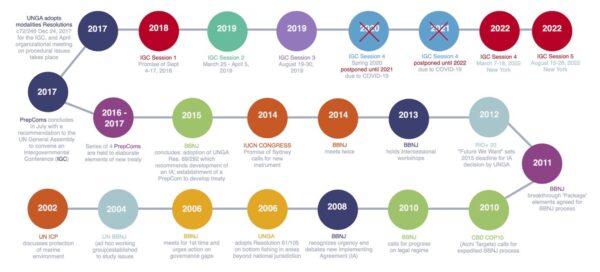Failure in efforts to create global ocean treaty
A fifth effort to pass a global agreement to protect the world’s oceans and marine life has failed. Numerous news outlets, including the BBC, reported that talks to pass the UN High Seas Treaty had been ongoing for two weeks in New York, but governments could not agree on the terms at the close of negotiations on August 26th. (photo credit: High Seas Alliance).
Despite international waters representing nearly two-thirds of the world’s oceans, only 1.2% is protected. The high seas begin at the border of a nation’s exclusive economic zone (EEZ), which by international law reaches no more than 200 nautical miles (370 kilometres) from its coast, and beyond any state’s jurisdiction. Sixty percent of the world’s oceans fall under this category
The last international agreement on ocean protection was signed 40 years ago in 1982 – the UN Convention on the Law of the Sea. That agreement established an area called the high seas – international waters where all countries have a right to fish, ship and do research.
Over two weeks 168 members of the original treaty, including the EU, came together to try and make a new agreement.
The negotiations focused on four key areas:
- Establishing marine protected areas
- Improving environmental impact assessments
- Providing finance and capacity building to developing countries
- Sharing of marine genetic resources – biological material from plants and animals in the ocean that can have benefits for society, such as pharmaceuticals, industrial processes and food
The treaty will not outline what areas of the ocean will be placed under marine protection – just the process by which organisations and countries can apply for it. Equally the treaty is not expected to include exact figures on what financial support developing nations will receive from developed countries. More than 70 countries prior to the meeting had already agreed to put 30% of the world’s oceans into protected areas. This would put limits on how much fishing can take place, the routes of shipping lanes and exploration activities like deep sea mining.
Sticking points
Countries failed to reach agreement on key issues of fishing rights, how to establish marine protected areas on the high seas and funding and support for developing countries. There had been hope that an agreement was near after world leaders at the UN Ocean Conference in Lisbon in July promised to do everything in their power to save the world’s seas, although the closing statement at that event included few clear commitments. Al Jazeera reported that the sharing of possible profits from the development of resources in international waters, remained a sensitive issue in the discussion in New York.
The treaty has been described as “the most significant ocean protection agreement for four decades”, the Guardian reported. The newspaper went on to say that a group of more than 50 countries known as the High Ambition Coalition committed last year to protect 30% of the planet’s land and sea by 2030. But without an agreement, these pledges have no legal basis in the high seas, which cover almost half of the earth’s surface and account for two-thirds of the global ocean.
Greenpeace International blamed the High Ambition Coalition: “countries did not do their homework on time, and moved towards compromises on key issues like finance far too late, jeopardising all other progress made at this round of talks. As a result, unless Ministers convene an emergency meeting in 2022 to conclude negotiations, the High Ambition Coalition and others like the U.S have failed to deliver on their commitment to finalise a Treaty this year.”
“While some groups, like the Pacific islands and the Caribbean group, have pushed hard to bring the Treaty across the finishing line, Global North countries have only started working to reach compromises in the final days of negotiations”.
Just 10 industrialized countries account for 71% of fishing catch value and 98% of patents on genetic sequences of marine life in the high seas. Mongabay reported that the disparity between industrialized and less-industrialised countries permeated all levels of the conference.
What next?
Formal and informal discussions have been continuing for some 15 years. “Although we did make excellent progress, we still do need a little bit more time to progress towards the finish line,” Al Jazeera reported conference chair and UN oceans ambassador Rena Lee as saying.
Members of the NGO the High Seas Alliance are asking States what they intend to do now, with widespread disappointment but also acknowledgement of progress at the talks.
It is not yet clear when countries will come back together to continue negotiations – but a deadline has been set for the end of the year. The talks will resume next year unless a special emergency session is called before the end of 2022.
U.S. Assistant Secretary of State Monica Medina voiced disappointment but expressed hope that the work done so far would carry forward, the Huffington Post reported. She said the United States remained committed to the goal of protecting at least 30% of the world’s oceans by 2030. “We cannot let the tides and currents push us back. We must keep going,” Medina said.
